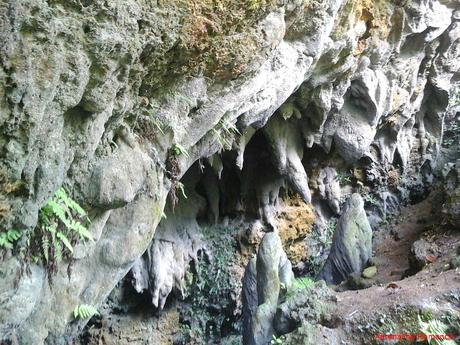
Kruhay from Antique! Raw, primal, scenic, fascinating—these are just some of the adjectives that we can use to describe this amazing province in Western Visayas, Philippines. In her bosom, Antique proudly holds a lot of natural, historical, cultural, and culinary attractions that are off the charts in grandeur. But despite its magnificence, Antique is a mere blip in the adventure tourism radar.
Our enchantment with Antique began when we visited Tibiao as a side trip after our Mt. Guiting-guiting climb earlier this year. Thus, we were quite honored to accept the invitation of Sir Flord Calawag, the OIC of the Antique Provincial Tourism Office. He invited us and a few other bloggers, writers, and digital media influencers on an adventure-filled one-week familiarization tour, dubbed Experience Antique, around the beautiful province.
Antique’s take on tourism is absolutely noble and effective. They implemented an ingenious approach that turns farmers, craftsmen, households, carenderia owners, mountain guides, and other constituents of a community into vital stakeholders for local tourism. This is a far cry from the usual method that gives the reins of tourism to private tour operators, hotels, and corporate outfitters.
Sir Flord and his wife fetched us at the Kalibo airport as soon as our aircraft landed. After a two-and-a-half ride into the starless night, we reached the quiet resort of Villa Teodora where clean sheets, fluffy pillows, and clean beds await us. We had a restful sleep in an air-conditioned villa.
We woke up serenaded by playful birds along with the sound of rustling leaves, the monotonous crash of waves in the nearby beach, and the soft laughter of workers who develop green and shady Villa Teodora to perfection.
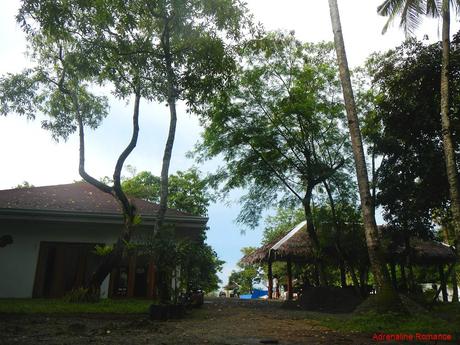
“Breakfast!” Sir Flord called. We went into the dining hall where smiling and friendly tourism officers welcomed us. We were treated to a delicious breakfast of grilled and tinola-style tuna. Tuna is quite plentiful in Libertad and is one of the major aquaculture products in the municipality.
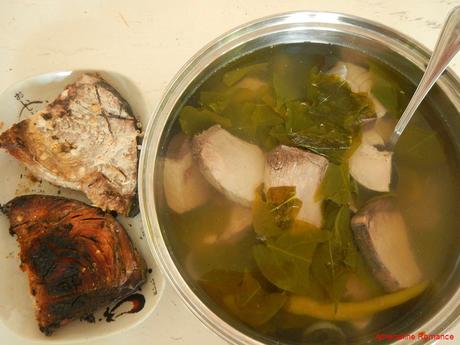
Pajo Marine Sanctuary
After gorging ourselves with chunks of tender fish, we were ready for our Explore Antique familiarization tour starting with Libertad, the northernmost municipality in the province. We loaded into a van and rode towards the nearby barangay of Pajo, our first destination for this week-long adventure.
It’s quite a strange, unfamiliar feeling with a police escort following us. Hehehe!
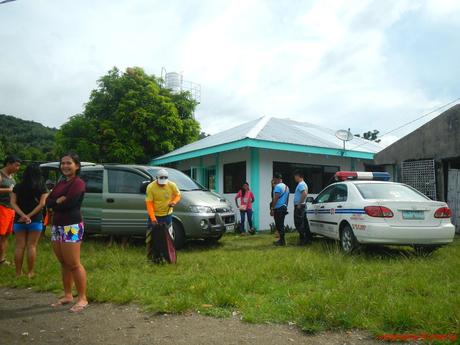
After a short briefing and having the honor of fitting ourselves with brand-new snorkeling gear, we headed out to the Pajo beachfront. At first glance, it looks just like an ordinary village beach with coarse brown sand and pieces of dead washed-out corals. The seascape though is awesome as it shows the majestic, faraway blue mountains of Antique.
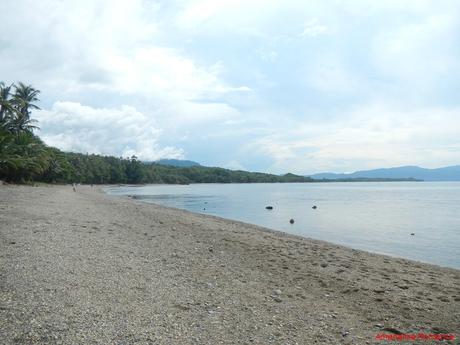
Bantay Dagat officers and fishermen rowed us several hundred yards into the midst of a previously unknown 5-hectare marine sanctuary. At such a shallow depth, we can already see the bountiful coral formations under the clear water.
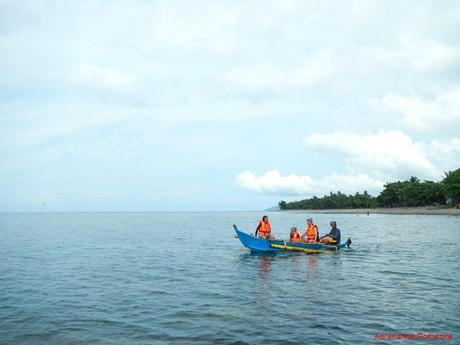
We were treated to an underwater spectacle once we entered the warm water. All around us were untouched and healthy corals that made the underwater landscape look like a vibrant, biological city.
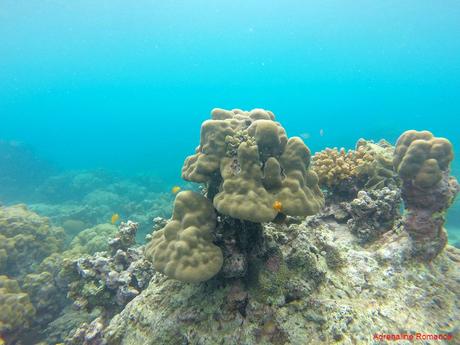
Most of the corals in the Pajo Marine Sanctuary are hard corals. We haven’t seen soft-bodied corals or anemones during our snorkeling activity.
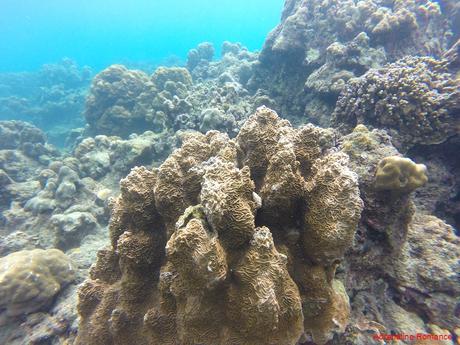
Check out this cool ball of coral. It is encrusted with barnacles, algae, and sand dollars.
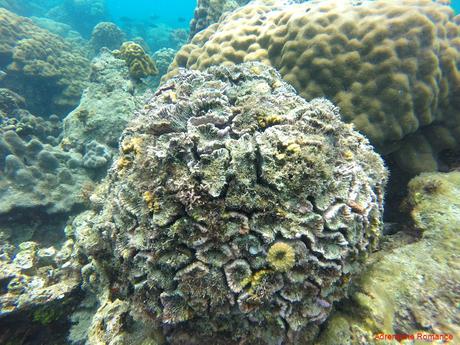
Hard corals make excellent, protective homes for lots of fish. It is also a playground for crustaceans that are barely visible to the naked eye.
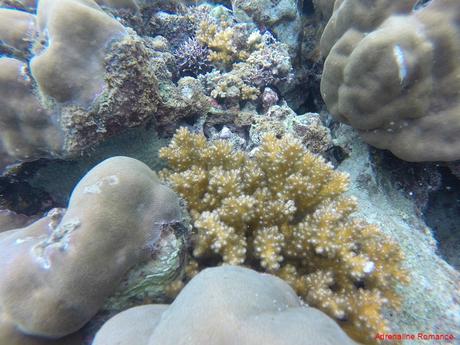
This table coral is most likely a cleaning station. Check out the two blue cleaning wrasses; they’re doing a special dance to attract fish to their cleaning station. Client fish allow wrasses to eat off the dead skin, scales, and parasites on their bodies, gills, and even inside their mouths.
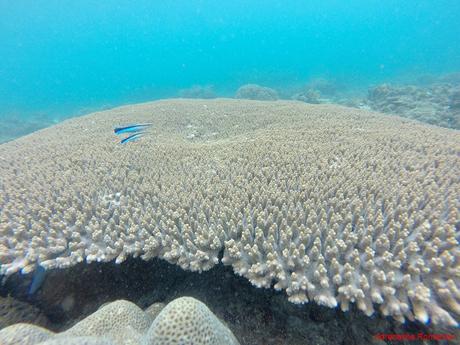
Uh oh! The crown-of-thorns starfish is the number one natural and biological predator of corals. They use enzymes to dissolve the hard exoskeleton of corals so they can gain access to the soft meat inside. An infestation of crown-of-thorns starfish can decimate entire coral reefs.
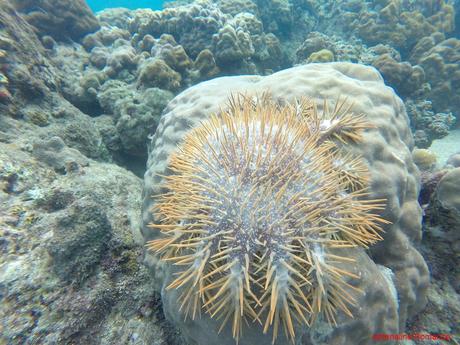
Some of the most beautiful and amazing denizens of the Pajo Marine Sanctuary are the giant clams that lie motionless on the sea floor. Once sought after for their delicious meat, giant clams are now legally protected by law.
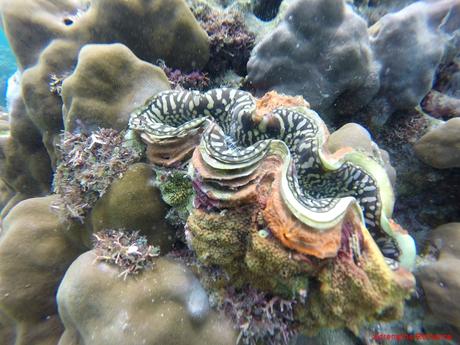
This giant clam has embedded itself into a large boulder star coral. Check out its colorful blue mantle.
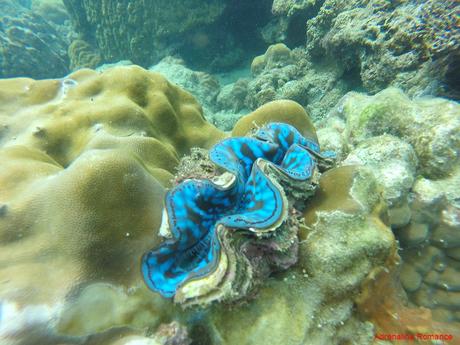
Maanghit Cave
After more than an hour of hovering above the colorful coral fields of the Pajo Marine Sanctuary, it was time to head to the nearby barangay of Union to explore another natural wonder. To do so, we left our van at Union’s small town center and rode powerful habal-habals over a kilometer of rough, unpaved road.

We disembarked from the habal-habals and started a short 30-minute hike across farmlands together with guides, tourism officers, and a few locals who were gleefully curious of the unexpected presence of strangers. At times, there was no choice but to cross flowing streams and get our feet wet.
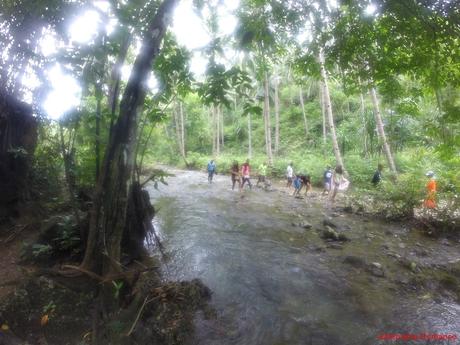
Close to noon, we arrived at the huge maw of Maanghit Cave, Union’s major natural attraction. Those stalactites look like the teeth of some unspeakable monster.
As our guide briefed us of the necessary caving protocols, we couldn’t help but smell the scent of unwashed armpits without deodorant. Are we that stinky?
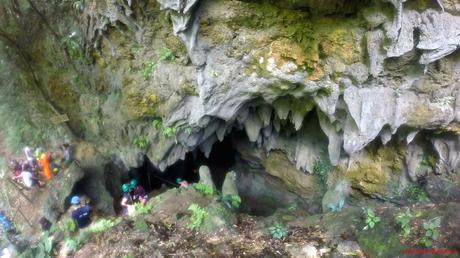
Well, it turned out that the scent comes from the mounds of guano (bat poop) inside the cave itself. In the Kinaray-a dialect, “maanghit” means a bad smell. In Bisaya, it refers to the musky scent of underarms. The stink became more pungent as we descended deep into the cave, guided by these carved steps and bamboo rails.
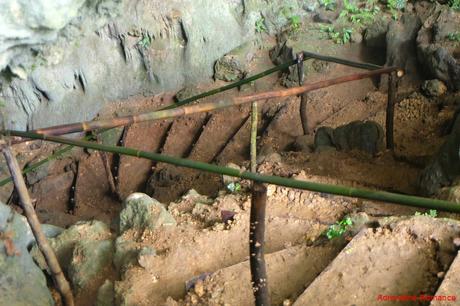
(Photo credit: Jessica Ayun)
By geological standards, Maanghit Cave is not large. However, it is the home of thousands upon thousands of fruit bats who take up residence in the strange stalactites, depressions, and rock formations high above us.
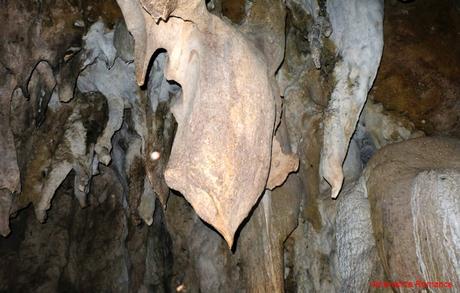
(Photo credit: Jessica Ayun)
Unlike other show caves that we’ve visited, Maanghit Cave is not dead. Well, it could have been if not for the valiant efforts of the locals to stop greedy businessmen from harvesting of guano and stalactites during the 1970s.
The marvelous flowstones, glittering crystalline formations, and unceasing trickles of water meant that the cave is very much alive.
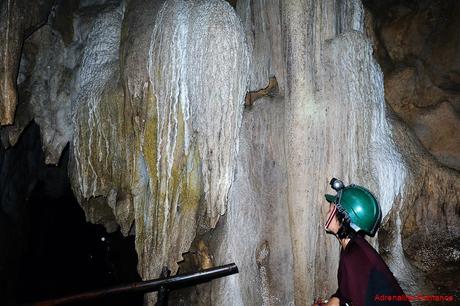
(Photo credit: Jessica Ayun)
There are numerous tailless whip scorpions in the cave. Despite their menacing appearance and name, they are actually harmless and would scuttle away if something gets too close them.
Other denizens inside the cave include fruit and pygmy bats (thousands of which hovered above us), tarantulas, cave crickets, geckos, snakes, and more.
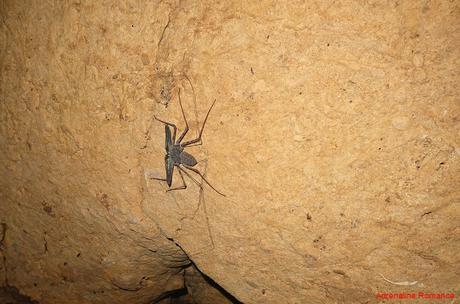
(Photo credit: Jessica Ayun)
The stellar attraction in Maanghit Cave’s main chamber is this flowstone called The Blessed Virgin Mary due to its rough resemblance to the iconic Christian image. The Blessed Virgin Mary is encrusted with millions of gypsum crystals, which makes the formation glitter.
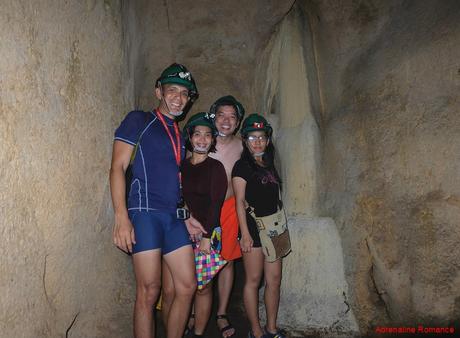
(Photo credit: Jessica Ayun)
After visiting the main chamber, we decided to explore the deeper section of Maanghit Cave. We need to duck so we could fit in the small hole that serves as the entrance to this darker and more mysterious section of the cave.
The unmistakable sound of flowing water echoes inside the tunnel.
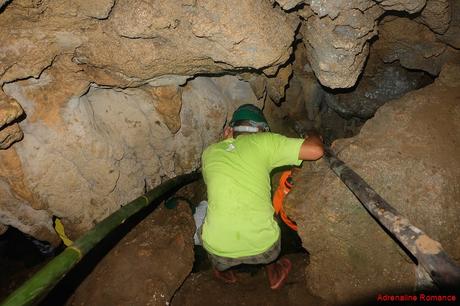
(Photo credit: Jessica Ayun)
It turned out that there is indeed an underground stream in Maanghit Cave. The stream is shallow, and in most of the way, the water only reaches to our calves.

(Photo credit: Antique Provincial Tourism Office)
Noisily sloshing our way against the flow of the stream, we came across some gorgeous rock formations that are continuously formed and polished by water. Small traces of graffiti suggests that people sometimes come here to explore this part of the cave.
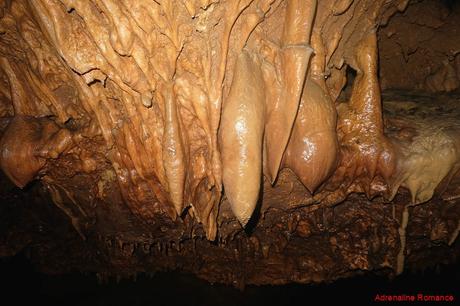
(Photo credit: Jessica Ayun)
We had to be extra careful because we don’t want to touch and damage those magnificent flowstones and rock formations all around the underground stream tunnel.
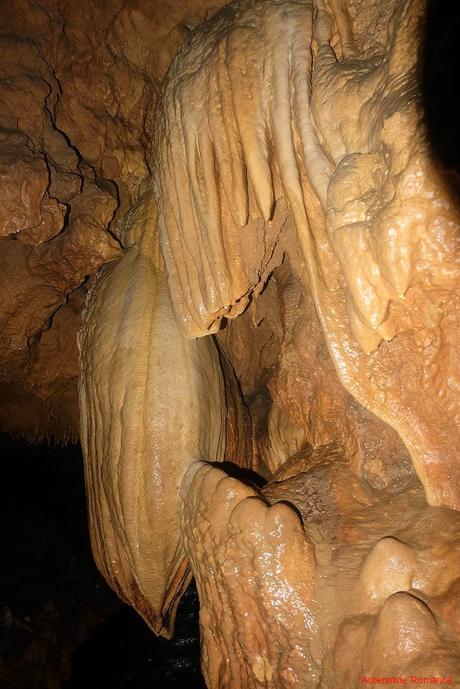
(Photo credit: Jessica Ayun)
Numerous, fragile stalactites hang above our heads. We had to duck to avoid hitting into them as a small bump can break them off.
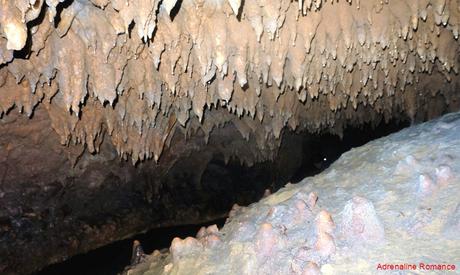
(Photo credit: Jessica Ayun)
After about half an hour of exploring the underground stream and admiring the alien rock formations, we stopped at a Y-junction. Going further in either two branches require more preparation and equipment, thus we recommended to the guides that this spot should be the stop for regular tourists. Those who want to explore further should acquire a special permit from the LGU.
We just squatted and enjoyed the cool, clear water running down our butts and lower limbs.
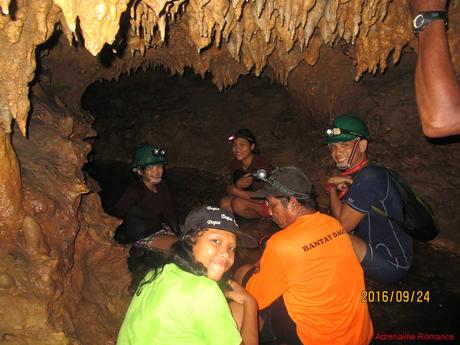
(Photo credit: Antique Provincial Tourism Office)
Bungan-Bungan Spring
Feeling the pangs of hunger starting to bite, we exited the cave and headed back to our shady jump-off point, which is conveniently located right beside a rushing stream. When we arrived, a delicious boodle fight feast consisting of chicken adobo, slices of grilled tuna, and rice noodles awaited us.
Our hunger approached greed, and we chomped up huge mouthfuls of the simple but sumptuous lunch.
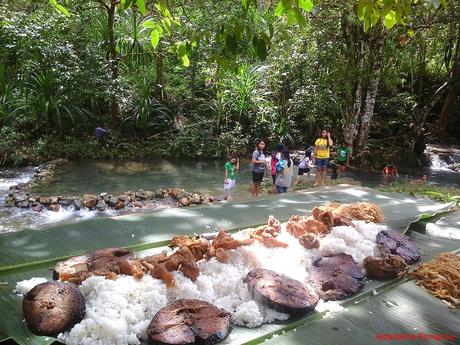
According to the day’s itinerary, we still had plenty of time to relax. Thus, we took a refreshing dip in the chilly, mint-green water of Bungan-Bungan spring, one of the favorite recreational areas for people of all ages in Union.
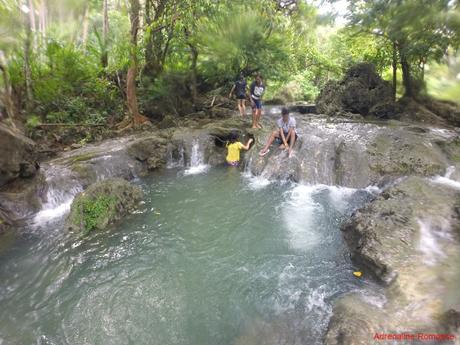
The water that feeds the stream actually comes from the underground stream in Maanghit Cave and Nipa River.
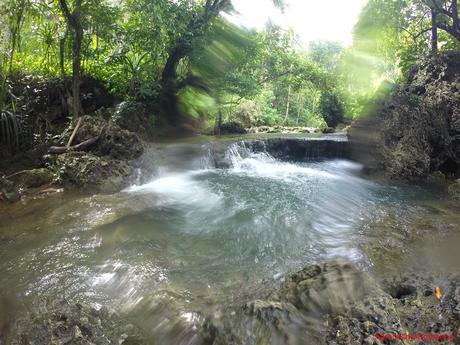
Bungan-Bungan Spring has several “levels,” ranging from shin-deep basins to pools a few feet deep. The section of the pool in the photo below is more than 6 feet deep and is ideal for short dives.
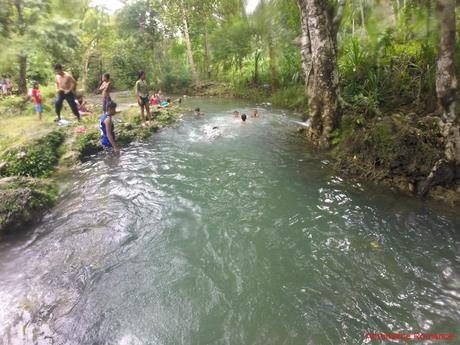
Sweetie stayed most of the time in a nice basin that is just big enough for her. The falling water massaged her; yes, it’s a natural jacuzzi!
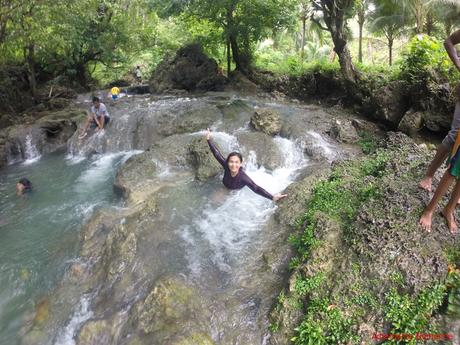
Banig Weaving in Ati Cave
While we relaxed at the Bungan-Bungan Spring, we noticed a guy carrying a huge bunch of what looks like some sort of palm leaves on his shoulders. What could they be? Let’s find out.
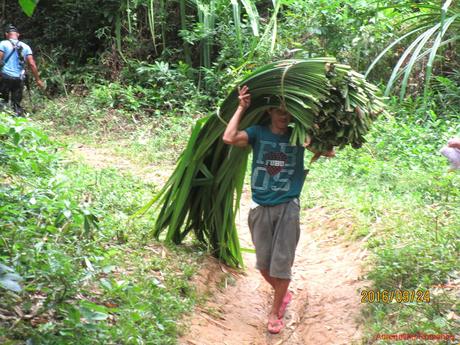
According to the man, these are freshly harvested leaves of the bariw plant, a local variety of pandan. He was going to deliver it to a group of indigenous craftswomen in a hidden cave. Hmmm…this is quite interesting.
Check out the wicked, spiky edges of the leaves.
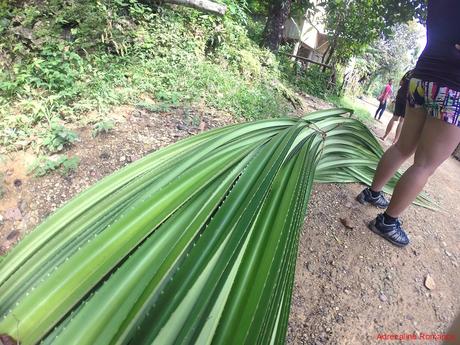
We endured a short 20-minute hike into a grassy coconut grove. Beyond that grove is a lightly wooded area where our next destination lies hidden.

We arrived at the dark but surprisingly lively cavern of Ati Cave (Kweba it Ati) where elderly indigenous Ati weavers were busy stripping the spikes of bariw leaves. This is dangerous work as it requires the use of a small, razor-sharp sanggut (a sort of farming implement) to shave off the spines. The index finger is used to guide the blade of the sanggut.
If you are not careful, you can either get your finger sliced by the sharp blade or have your skin punctured by the spines. Choose one.
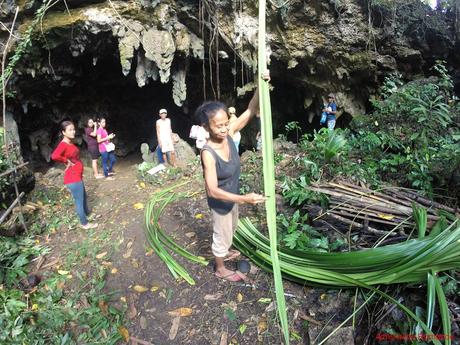
A stern-looking elder showed us how to harvest the bariw leaves. He uses a pole with a sanggut and a hook at the end. He slices and pulls out the leaves; he doesn’t need to climb the tree.
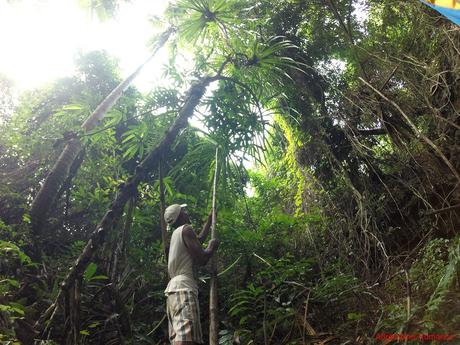
The leaves are then dried for days under the sun. As they dry, they begin to shrink and wilt. At the right time, the weavers then take the dried fronds inside Ati Cave. Inside the cavern, they vigorously pound on the leaves to thin them out. This process can take several hours.
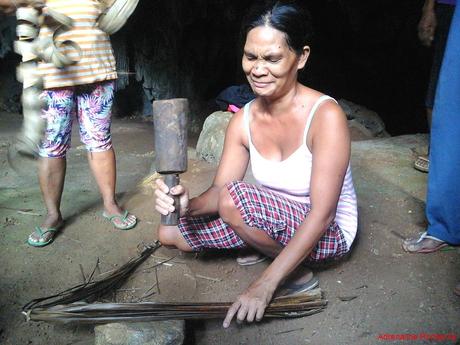
Once the leaves are sufficiently thin, the weavers slice them lengthwise, using a rudimentary contraption fashioned out of blocks of wood and razor blades.

The thin, sliced bariw leaves are now woven into a banig, or mat. The painstaking process is entirely done by hand, and we were truly impressed by the skills of these Ati weavers. Watching them passionately doing their craft is like being mesmerized in a magic show. It’s more than a work of art; it’s a work of heart.
As it turned out, the ancient art and knowledge of banig weaving has been passed from generation to generation. It has remained one of the primary sources of livelihood for townsfolk.
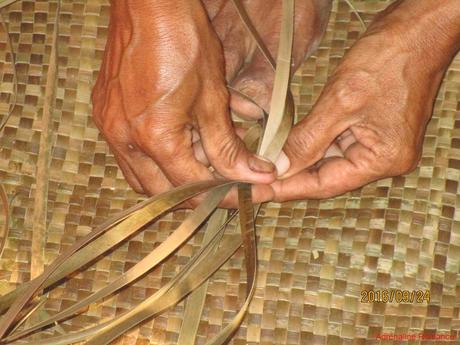
But should they practice the art of banig weaving in a cave? Yes, and it is an absolute necessity. The Atis explained that the coolness and right amount of humidity in the cave help strengthen and improve the elasticity of the bariw leaves. If they weave in a dry place such as a concrete floor, the bariw strands will become brittle.
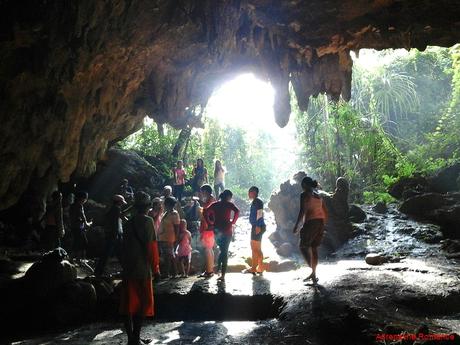
It was virtually empty when we visited Ati Cave, but the women said that during summer, weavers from all around Libertad congregate inside the cavern. Just like washing laundry in the river, they exchange gossips, laughter, and the latest talk of the town while crafting beautifully woven banigs.
During hot season, non-weavers also take shelter in the cool cave to escape the sweltering heat.
The Ati Cave also had a practical, life-saving purpose. In World War 2, it served as a hidden sanctuary for locals from the sight of Japanese soldiers.
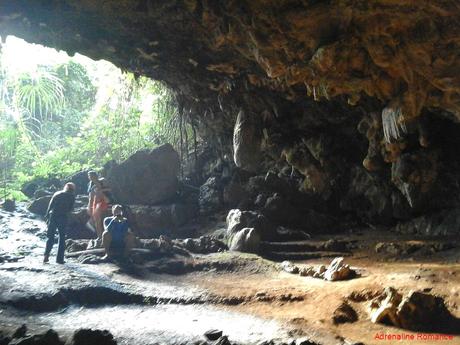
These happy Atis displayed their world-class banigs for us. Would you believe that six of those women are siblings who have been weaving banigs for all their lives? Amazing!
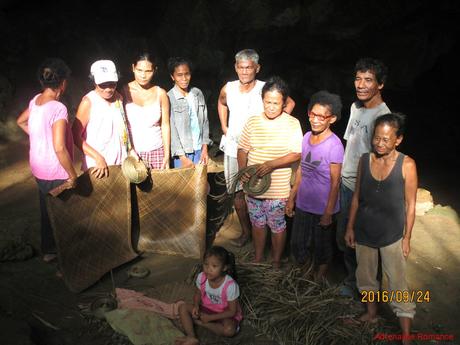
After getting absolutely dazzled by craftsmanship of the Atis, we exited Ati Cave and walked back to the coconut grove. Here, we feasted on huge servings of locally made cassava pudding for merienda. Cassava pudding is one of Antique’s many unique delicacies.
We love the soft, flan-like, melts-in-your-mouth texture of the dessert.
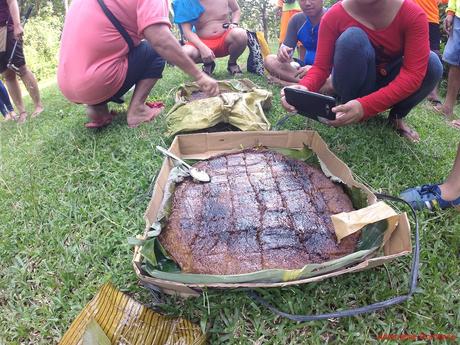
Bariw banigs are not just used as sleeping or picnic mats. When we went to the multi-purpose coop later, we found out that they are also sewn to make bags and purses. Sweetie and I bought a nice bariw purse.
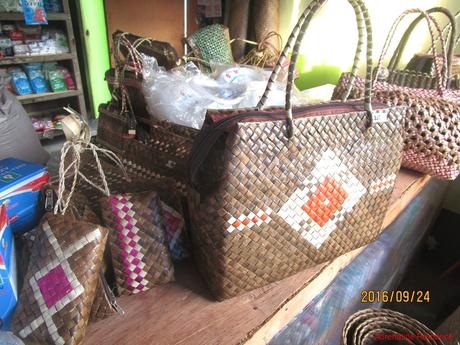
Gate Crashing a Children’s Party!
As the sky darkened to give way to dusk, we stopped by a house to pay Maam Mary Jean Te, Libertad’s mayor, a courtesy call. Well, it turned out that the mayor was celebrating a family friend’s daughter’s kiddie birthday party!
That was totally unexpected, and we shyly joined the celebration wearing our maanghit, muddy, and wet clothes! We had a dinner of crispy lechon, cake, and other Filipino party food.
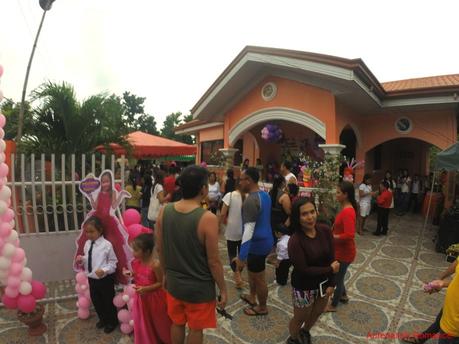
Antique’s community-based tourism is still in its infancy, but our trip around Libertad shows that the methodology holds a lot of positive promise. For visitors, it offers a more exciting adventure, a more genuine interaction with nature and local people, an escape from attractions overwhelmed with hordes of tourists, and a more authentic regional experience. For locals, community-based tourism enables them to generate extra income, discover natural treasures within their backyards, and realize the importance of protecting their community’s treasures.
Experience charming Libertad, and indulge in a fun-filled, educational weekend!
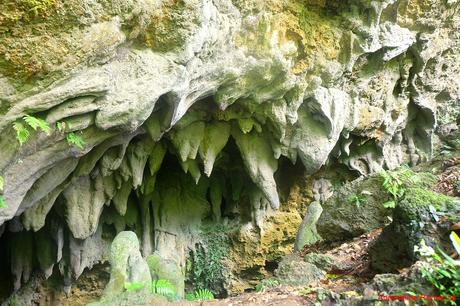
(Photo credit: Jessica Ayun)
Contact Details
To facilitate your tour around Libertad, Antique, get in touch with the following:
- Mr. Galahad Garcia (Libertad Municipal Tourism Officer) – 0929-769-4753
- Mr. Flord Calawag (OIC Antique Provincial Tourism Office) – 0927-699-5727 / 0919-813-9893
- Ms. Jola Lyn Tingson (Antique Natural Tourism Program Head) – 0977-811-0017
We strongly recommend contacting any of these officers before your trip so they can coordinate with the accommodation providers and the necessary people to help you in your adventures. They are the best people to go to if you want your adventure to be smooth-sailing.
Once you arrive in Libertad, head first to the municipal hall to register. Then see the tourism officer/staff for assistance.
Getting to Libertad
Option 1: Ride a bus or an air-conditioned van from Kalibo to Libertad.
Option 2: Ride a bus from Kalibo to Pandan, which should take about an hour. From Pandan, take a tricycle or a jeepney to Libertad.
Rates*
- P 80 per person – bus fare from Kalibo to Libertad (for Option 1)
- P 100 per person – air conditioned van (for Option 1)
- P 70 per person (estimated) – bus fare from Kalibo to Pandan (for Option 2)
- P 20 per person (estimated) – tricycle or jeepney fare from Pandan to Libertad (for Option 2)
- P 20 per person – habal-habal fare from Libertad to Barangay Union
- P 15 per person – tricycle fare from Libertad to Barangay Union
- P 50 per person (one way) – habal-habal rate from Union to Bungan-Bungan Spring, Maanghit Cave, and Api Cave
- P 200 per guide (1 guide per 5 guests) – guide fee for Maanghit Cave
- P 50 per person – environmental fee
- P 200 per guide (1 guide per 5 guests) – guide fee for Ati Cave, including banig weaving demonstration
- TBN (To be negotiated) – snorkeling fee at the Pajo Marine Sanctuary. Please coordinate with the Libertad Tourism Office since official standard rates are not yet established as of this writing.
* Rates are subject to change without prior notice. We did not include our expenses for meals, snacks, souvenirs, accommodations, tips, and other fees in this rate sheet as you may have different needs, preferences, itineraries, and sharing scheme from us.
Tips
1. Since the attractions in Libertad are spaced out at a considerable distance from each other, we strongly recommend hiring a habal-habal or tricycle for a day. Not only will you help the local economy, but the drivers can give you wonderful insights about their town. Ask the help of the tourism office to help you secure a habal-habal or tricycle and negotiate the rates.
2. For large groups or for a more private tour, you can hire an air-conditioned van from Southwest Tours. Use the following contact details:
- Cellphone Numbers: 0917 568 2441 or 0947 891 1658
- Email: [email protected]
3. For accommodations in Libertad, go to Villa Teodora in Barangay Barusbus. Get in touch with Resort Manager Ms. Marites Guiyab at 0918-266-1055.
Pajo Marine Sanctuary
1. At the Pajo Marine Sanctuary, snorkeling equipment is provided by the municipality. However, since these are basic, you may want to bring your own snorkeling equipment and PFD.
2. The Pajo Marine Sanctuary is very pristine. However, after this blog post and once the LGU establishes the mechanisms, policies, and advertising machinery, we are expecting more people to come and visit the sanctuary.
The presence of humans will definitely be a threat to the stability and survival of the sanctuary. Thus, it is imperative to observe responsible eco-tourism practices. To preserve the marine sanctuary, please strictly observe the following rules:
- For safety, stay near your boat
- Always wear a PFD (life jacket) even if you know how to swim. The PFD allows you to float on the surface of the water, which lessens the chances of touching or stepping on the corals.
- Be careful when using your fins. One careless kick from a fin can damage the corals.
- Do not snorkel during extremely low tide. Your body may scrape the top of the corals. You can start snorkeling when the water is waist-deep.
- You may wish to free dive and take a closer look, but your PFD prevents you from doing so. Ask your guide or snorkeling buddy to accompany you to deeper water (at least 8 to 10 feet deep).
- From there, you can take off your PFD and dive, being careful not to touch the corals.
- Avoid moving a lot. Swim slowly and gently. Unnecessary strokes run the risk of hitting the corals.
- Do not disturb wildlife. Just float back and observe the natural activities.
- Avoid wearing sunscreen. Sunscreen has harsh and toxic ingredients that can harm the corals.
- If you absolutely need to put your feet on the seabed, find a sandy patch first before putting down your feet. We recommend wearing protective foot gear such as aqua shoes.
- Please mind your trash; it does not belong to the sanctuary. Do not leave any of your garbage behind.
3. Whatever yo do, never touch, step on, or break corals. The slightest touch can compromise their protective mucus layer, which can damage them. Don’t even think of taking one as a souvenir! Corals are very delicate and form an important part of the sea’s ecosystem.
Maanghit Cave
1. Although Maanghit Cave is the main attraction in Libertad, caving as a tourism activity is not yet widely known. Do not expect any proper caving equipment to be provided. At most, the setup would just be an engineering helmet and a basic flashlight or headlamp.
Thus, if possible, bring your own gear. Maanghit Cave does not require any technical climbing or descending, so you don’t need any specialized equipment. However, we strongly recommend you bring the following:
- helmet
- headlamp
- extra flashlight
- extra batteries for your light sources
- long-sleeved rashguard or shirt
- arm guards and leg guards
- trekking pants
- lightweight gloves
- trekking shoes
2. For safety purposes, do not go beyond the Y-junction in the underground stream since the branches are not yet charted. If you want to initiate the exploration, coordinate with the Libertad LGU via its tourism officer.
3. Never touch stalagmites, stalactites, and unique rock formations, especially those that are wet, glittering, or dripping. These are very delicate, and the slightest touch can “kill” them. Only hold on to boulders and “dead” rocks.
4. Do not go inside the cave if it’s raining. The underground stream might get flooded. Also, moss-covered limestone can be dangerously slippery on wet conditions.
5. We recommend wearing good-quality trekking shoes or sandals with a thick sole and an aggressive tread. The trail is quite rocky, and your footwear will definitely need to endure a good beating.
Ati Cave
1. According to the Antique Tourism Office, the DENR conducted a cave assessment last Sept. 2015. The body qualified Ati Cave as a Class III cave which means:
- Together with a site guide, inexperienced visitors can safely go inside the cave.
- There are no threatened species of flora and fauna inside the cave.
- There are no significant archaeological items in the cave.
Others
1. Pack light but bring the following:
- water (at least 2 liters)
- swimwear
- dry clothes
- trekking shoes or sandals
- umbrella, hat, or scarf and sunglasses
- rain gear (in case of bad weather)
- extra money for emergencies
- medications (if any)
- toiletries
- face towel
- snacks
- packed lunch
2. Do not vandalize the Maanghit and Ati Caves. Do not litter inside, and bring all your garbage with you. Never bring artifacts, rocks, or crystals with you. Remember that these caves are natural wonders and sacred sites. All cave systems are very delicate, and a careless group could irreversibly damage the cave.

